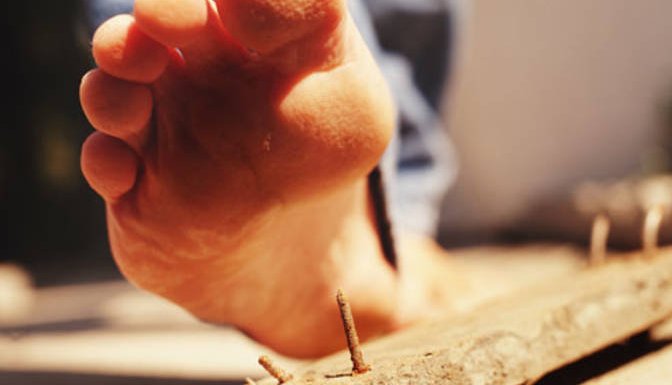The Other Side of the Tetanus Infection Story – More #FakeNews by the Mainstream Media

When it comes to the media and the so-called Skeptic community, there is a real double-standard in regards to the value of not only our children but our rights to keep them safe from harm as we see fit – whether that is the harm posed by disease or the harm posed by vaccines.
Children who have been hurt by diseases and their families are treated like saints. They are sanctified in the corridors of government (with many of them becoming unqualified consultants on government vaccination policy), in the press and amongst their fellow citizens.
Those who were harmed by vaccines, however, are told to shut up, stop their whinging and, even worse, are told that they are imagining what they saw with their own eyes. Their children are invisible, disregarded and just considered to be the sacrificial virgins thrown into the volcano to save everyone else’s children.
Worst of all, however, is the treatment that parents of unvaccinated children receive when someone in their family contracts or is harmed by one of the diseases covered by our vaccination schedule. These parents are treated like criminals, openly and gleefully abused and basically told they are getting what they deserve without any question about what actually happened.
The media and incomplete, biased coverage
Yesterday, there was a story on the ABC as well as in the Northern Star newspaper about a family whose child was near death in hospital from a tetanus infection. This young, 7-year old girl had been transferred from Lismore Base Hospital to the Lady Cilento Hospital in Brisbane for emergency treatment and was near death. Everyone from the paediatrician who saw her in Lismore to the members of various internet hate groups to random commentators on Facebook and other social media outlets were having a go at the parents of this little girl and blaming them for her condition.
I’ve spoken with someone who knows this family well and have gotten the real story about this child’s illness and the family’s reasons for rejecting vaccines. Rather than being a story of irresponsible parenting, one could possibly make a case that this is instead a case of medical negligence based on ignorance of the symptoms of tetanus infections and potentially incorrect or incomplete cleaning of the child’s wound in the first instance.
I was told that this little girl had two members of her family who reacted badly to vaccines – one of whom nearly died from a tetanus shot. Another close relative had a serious reaction to a different vaccine which led to long-term physical problems. As a result, this family had made an informed decision not to take a risk with the tetanus vaccine. I will include more about tetanus and the vaccination at the end of this blog post.
The history of this case
On the 21st of February, a brick was dropped on this child’s toe, crushing the toe and nail badly. Her parents brought her to the local Nimbin Hospital where she was treated for this wound. They took here there once a day to get her dressing changed. The schedule later went to once every two days and then, as the wound appeared to be healing, once every few days. All this time, the child was being seen by doctors and hospital staff and was thought to be improving.
Her doctor noted that the nail would grow back crooked if she did not receive further treatment so surgery was performed on her toe to remove and reinsert the nail. This was done a couple of weeks after the initial injury took place.
Tetanus-recognised by friends and family but not by the medical staff
Lockjaw, one of the most common early symptoms of a tetanus infection, did not start to present itself until approximately 10 days later. Although she had been brought to hospital several times over this period, and her parents had asked the doctors about whether or not their daughter might have tetanus, they were always told no.
On Monday, March 13th, she was taken to a physio because of a sore back and the physio thought perhaps it was a growth spurt. That night, she woke up crying every 15 minutes so her mother slept with her and found she was waking to convulsions. She had no fever. She had weak legs and difficulty standing up. She could not open her mouth very wide and her jaw hurt when she tried to.
The parents want to make clear that they feel the medical staff did their best over this entire period and were very respectful towards them and their daughter, but no one had had any prior experience with tetanus. Regardless of this, the parents had expressed concern a number of times over their hospital visits regarding tetanus. They had pushed the point that they felt it could be tetanus and the staff had dismissed these concerns.
The child’s condition worsens
On Tuesday, March 14th at 3:30 pm, the little girl saw the local doctor who phoned a paediatrician for advice. Neither had had any experience with tetanus and felt it best she be taken to Lismore Base Hospital either that night or the next day. The parents were very concerned and rushed her in that night.
At Lismore Base Hospital, they finally diagnosed her with tetanus and gave her two vials of tetanus immunoglobulin as that was all they had. She was placed on a ventilator and rushed to The Lady Cilento children’s hospital in Brisbane. Once at Lady Cilento, they gave her more immunoglobulin. They removed the toenail to make sure the site had been cleaned correctly and no tetanus spores remained.
The girl has now stabilised and is doing well. It was thought that she would be off of the ventilator last night and was hopefully improving now after receiving the proper treatment.
The parents have said although questioned about their stance on vaccines, all staff in all three hospitals were respectful and were doing their best with the knowledge and experience they had.
What is tetanus?
To start with, for all those out there who are filled with fear by this story, I need to tell you that tetanus is not a transmissible disease. A person who has a tetanus infection cannot then give that disease to anyone else.
The infection is caused by a bacterium – clostridium tetani – which is anaerobic in nature – in other words, oxygen will kill it.
This bacteria lives quite happily and usually harmlessly in the gut of all mammals, including humans. The problem occurs when there is a deep puncture wound which (usually) does not bleed freely and is then covered, preventing oxygen from reaching the site.
A hydrogen peroxide solution is often applied to deep puncture wounds, forcing oxygen into the site and if necessary, there have been recommendations to apply pressure to the wound, forcing blood to the surface since blood is highly oxygenated. In addition, bleeding and cleaning should hopefully remove any tetanus spores which may be present.
I have heard many stories of hospital staff recommending tetanus boosters to patients who present with closed wounds (eg non-compound fractures, sprains and severe bruising without a break in the skin). From my reading, this should not be necessary since without an entry wound, tetanus should not be able to enter the body. It is also potentially unnecessary to administer a tetanus vaccine to someone who has had a wound that has no possible contamination with tetanus spores (carried in animal faeces, remember), such as someone who has cut their hand or foot on a broken glass in their kitchen or who has cut themselves with a clean knife, though I have been contacted by many people whose doctors had made this recommendation to them. Vaccines are not benign products. They carry with them real and in some cases, quantifiable risks of harm or death and their use should be limited to instances when the potential benefits outweigh any known risks.
Tetanus in Australia
Each year, an average of 7-10 (mostly elderly) Australian adults will contract tetanus infections. Many of these occur in diabetics who, due to a lack of circulation to their extremities, may not be aware of their wound and as a result, may not care for it properly.

Most of those who have contracted this illness since widespread vaccination began during and after WW II were at least partially, if not fully, vaccinated against it. The NNDSS (National Notifiable Diseases Surveillance System) has classed many of the elderly in Australia who contracted tetanus as being unvaccinated, but it is difficult to know if that means they have not received any tetanus vaccines or they had simply not received the recommended tetanus boosters and would, therefore, have been considered to be up-to-date.
The case of tetanus in this young child yesterday is only the second case in a child in Australia since 1991. The risk for an individual child is vanishingly small – though if that child happens to be yours, this statistic will be cold comfort.
Prevention
The tetanus toxoid vaccine has been used in other countries, as I stated earlier, since the 1920s. The first tetanus toxoid vaccine was introduced in Australia in 1939 (mostly for use in our armed services) and was not routinely administered to children until 1953 when our modern schedule of mass vaccination began. At that time, it was combined with diphtheria and pertussis shots to form the DTP vaccine.
This article, by Dutch physician Dr Kris Gaublomme, tells a great deal about the ineffectiveness and risks of this vaccine. The tetanus vaccine has been routinely administered in combination with diphtheria and pertussis (whooping cough) vaccines since early last century. Many reactions which occurred after the DTP combined shot were blamed on the pertussis component. But many of those who received the tetanus-only shot (no longer available in Australia) suffered severe and even life-threatening reactions to just that vaccine.
One of the noted reactions is something called hyperimmunisation. Tetanus boosters used to be recommended for adults every five years. It was found, however, that such frequent boosting could lead to hyperimmunisation, meaning that the vaccinated person would develop symptoms of a tetanus infection (lockjaw, severe muscle spasms, etc) without ever suffering a tetanus-prone wound.
One of the first people to contact me to report his vaccine injury to the AVN’s database in the early 1990s after the AVN first started was a local builder who had developed hyperimmunisation. As a builder, he was constantly getting injuries at work. Despite the fact that he was totally up-to-date with the government recommended schedule, every time he was admitted to hospital for treatment, he would be given a routine tetanus booster (Tet-Tox) without being asked about how long it had been since his last shot. He subsequently developed this condition, meaning that he would suffer from periods of lockjaw and extremely painful muscle spasms over and over again.
Alternatives to medical vaccination
As many of you would know, my eldest child was injured by his DTP and then MMR vaccines. My second child received DT (we left out the pertussis component – parents can no longer do that) and polio and my third child got polio only. My 4th is completely unvaccinated.
We live on a farm so were always aware of the potential risk of tetanus. Our solution was to always have hydrogen peroxide on hand, to clean and bathe any wounds the children got (and since they always ran around barefoot, as good country children do, there were many wounds!) and to bathe the area thoroughly in this solution. We also kept (and still keep) a vial of Ledum on hand. Ledum is one of the homeopathic remedies for tetanus and we would administer that to the children should they have a wound we felt might be at risk for a tetanus infection.
I have spoken with other families who have used other strategies to prevent tetanus infections. It is probably a good idea, if you are interested in this issue, to speak with your own trusted health professional to seek their opinion. There are several books I can recommend for further reading on this and other vaccination issues as well. I will list them in the bibliography at the end of this post.
Respect
I guess the takeaway message for this article is that parents will always love their children more than anyone else will. More than the doctors; more than the government; more than the pundit wanna-be’s at SAVN; and more than anyone in the media. They will make the decisions they feel are best for their family’s health based on the information they have at the time.
Life is filled with risk
On average, 7 children under the age of 15 are killed every year in Australia and 60 are injured after being run over by cars in their own driveways. These deaths and injuries would be (for the most part) preventable through the requirement to install reversing cameras in every car, ute and truck registered in this country. Yet the government has not made this recommendation nor do these children make front page news when such tragedies occur.
Why then is the finger of blame so often and so cruelly pointed at loving families who are doing the very best they can in a very difficult situation? There is no proof that tetanus vaccination would have prevented this child’s illness and a lot of potential evidence that earlier recognition by medical staff might have saved a lot of suffering.
We all do what we can, when we can to keep our children safe, happy and healthy. When something goes wrong, that is the time for us to come together and support each other – not to play the game of ‘what if’, ‘if only’ and ‘you should have…’.
Please try to keep that in mind the next time this situation arises. Especially those of you in the media who are the biggest and most public offenders.
Until then, I wish this family and their little girl all the very best for a quick and complete recovery to full and vital wellness.
by Meryl Dorey
Suggested reading:
Please note: Blog posts are opinion pieces which represent the views of the authors. They do not necessarily represent the viewpoints of the nocompulsoryvaccination blog. This blog is a forum, support and information site and outlet for discussion about the relative benefits and risks of vaccinations in particular – and medical procedures in general. We do not provide medical advice but believe that everyone has the opportunity and the obligation to do their own research before making decisions for their families. The information we provide (including your personal review of the references we cite) should be taken in conjunction with a range of other data, including that obtained from government, your health care provider and/or other medical source material to assist you in developing the knowledge required to make informed health choices.








